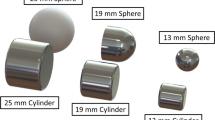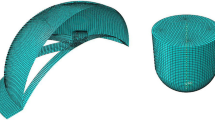Abstract
To evaluate and analyze the pedestrian injury risk of automobiles, the finite element models of headform impactors are used. In this study, a modeling method that can accurately estimate the peak of the headform impactor impact pulse and head injury criterion (HIC) was developed. The headform impactor skin has the characteristics of both hyperelasticity and viscoelasticity. Therefore, compression tests, stress relaxation tests, and rheometer tests were conducted, and the hyperelastic and viscoelastic models were developed. The models were combined and used in the finite element analysis. The new headform impactor model was verified to accurately estimate the peak of impact pulse and HIC at the certification test of the headform impactor.
Similar content being viewed by others
References
ASTM (2012). ASTM D-575 Standard Test Methods for Rubber Properties in Compression.
ASTM (2014). ASTM 6147-97 Test Method for Vulcanized Rubber and Thermoplastic Elastomer–Determination of Force Decay (Stress Relaxation) in Compression.
Belingardi, G., Chiandussi, G. and Gaviglio, I. (2005). Development and Validation of a New Finite Element Model of Human Head. 19th Int. Technical Conf. Enhanced Safety of Vehicles (ESV). Paper Number 05-0441.
Bower, A. F. (2009). Applied Mechanics of Solids. CRC Press. Roca Raton, Florida, USA.
Brinson, H. F. and Brinson, L. C. (2015). Polymer Engineering Science and Viscoelasticity. Springer. New York, USA.
Choi, J., Park, B. and Kim, J. (2012). Development and validation of FE adult headform impactor for pedestrian protection. Trans. Korean Society of Automotive Engineers 20, 2, 64–69.
Christensen, R. M. (1971). Theory of Viscoelasticity: An Introduction. Academic Press, New York. New York, USA.
Dassault Systems (2013). ABAQUS 6.13. ABAQUS User’s Manual.
Du Bois, P. A., Kolling, S., Koesters, M. and Frank, T. (2006). Material behaviour of polymers under impact loading. Int. J. Impact Engineering 32, 5, 725–740.
EEVC WG 17 (2002). Improved Test Methods to Evaluate Pedestrian Protection Affortded By Passenger Cars. EEVC Working Group 17 Report.
Frank, T., Kurz, A., Pitzer, M. and Sollner, M. (2003). Development and validation of numerical pedestrian impactor models. 4th European LS-DYNA Users Conf.
Gilchrist, M. D. (2003). Modelling and accident reconstruction of head impact injuries. Key Engineering Materials, 245-246, 417–429.
Hahmoudi, H. (2013). Modeling of Bonnet in LS-DYNA for Pedestrian Research. M. S. Thesis. Chalmers University of Technology. Gothenburg, Sweden.
Huanga, S. and Yanga, J. (2010). Optimization of a reversible hood for protecting a pedestrian’s head during car collisions. Accident Analysisand Prevention 42, 4, 1136–1143.
Humanetics (2016). http://www.humaneticsatd.com/crashtest-dummies/pedestrian/pedestrian-headforms
Jarlath, M. H. (2007). Ultrasound Technique for the Dynamic Mechanical Analysis (DMA) of Polymers. Ph. D. Dissertation. Technische University Berlin. Berlin, Germany.
Kamalakkannan, S., Guenther, D., Wiechel, J. and Stammen, J. (2005). MADYMO modeling of the IHRA head-form impactor. SAE Paper No. 2005-01-2740.
Li, R. (2000). Time-temperature superposition method for glass transition temperature of plastic materials. Materials Science and Engineering: A 278, 1–2, 36-45.
LSTC Corporation (2013). LS-DYNA Keyword User’s Manual, Version 971.
Masoumi, A., Shojaeefard, M. H. and Najibi, A. (2011). Comparison of steel, aluminum and composite bonnet in terms of pedestrian head impact. Safety Science 49, 10, 1371–1380.
Naci, H., Chisholm, D. and Baker, T. D. (2009). Distribution of Road Traffic Deaths by Road User Group: A Global Comparison. http://www.who.int/choice/ publications/RTI%20Distribution%20Article.pdf
Nobuhiro, I. (2003). Computational simulation for head impact on vehicle hoods using the precise finite element model. Proc. 18th Int. Technical Conf. Enhanced Safety of Vehicles, Nagoya, Japan, 19–22.
Ommaya, A. K., Thibault, L. and Bandak, F. A. (1994). Mechanisms of impact head injury. Int. J. Impact Engineering 15, 4, 535–560.
Qi, L., Yong, X. and Qing, Z. (2009). Friction effects in pedestrian headform impacts with engine hoods. Tsinghua Science and Technology 14, 5, 631–638.
Qing, Z., Huiling, D. and Fanzhong, K. (2004). Recent progress in pedestrian impact protection. Proc. China Int. Conf. Automotive Safety Technology, SAE-China, Beijing, China.
Samaka, H. and Tarlochan, F. (2013). Finite Element (FE) human head models/literature review. Int. J. Scientific & Technology Research 2, 7, 17–31.
Sulzer, J., Kamalakkannan, S. B., Wiechel, J. and Guenther, D. (2006). Simplified MADYMO model of the IHRA head-form impactor. SAE Paper No. 2006-01-2349.
Teng, T. L. and Nguyen, T. H. (2008). Development and validation of FE models of impactor for pedestrian testing. J. Mechanical Science and Technology 22, 9, 1660–1667.
Untaroiu, C., Shin, J., Crandal, J. and Crino, S. (2006). Development and validation of headform impactor finite element model with application to vehicle hood design for pedestrian protection. 9th Int. LS-DYNA Users Conf.
UNECE (United Nations Economic Commission for Europe) (2007). Final Report on the Development of a Global Technical Regulation Concerning Pedestrian Protection: Proposal for a Draft Global Technical Regulation on Pedestrian Safety.
UNECE (The United Nations Economic Commission for Europe) (2009). Global Technical Regulation No. 9: PEDESTRIAN SAFETY.
Wason, W. L. and Smith, O. J. (2000). Injury surveillance in Victoria, Australia: Developing comprehensive injury incidence estimates. Accident Analysis & Prevention 32, 2, 277–286.
Williams, M. L., Landel, R. F. and Ferry, J. D. (1995). The temperature dependence of relaxation mechanisms in amorphous polymers and other glass-forming liquids. J. American Chemical Society 77, 14, 3701–3707.
Ye, H., Zhu, M., Hu, P. and Lu, S. (2012). FE modeling method for a headform used in pedestrian protection simulations. Int. J. Automotive Technology 13, 4, 607–613.
Author information
Authors and Affiliations
Corresponding author
Rights and permissions
About this article
Cite this article
Lee, CR., Jeong, HY. Development of Headform Impactor Finite Element Model Considering the Hyperelastic and Viscoelastic Responses of Rubber. Int.J Automot. Technol. 19, 523–534 (2018). https://doi.org/10.1007/s12239-018-0050-z
Received:
Revised:
Accepted:
Published:
Issue Date:
DOI: https://doi.org/10.1007/s12239-018-0050-z




